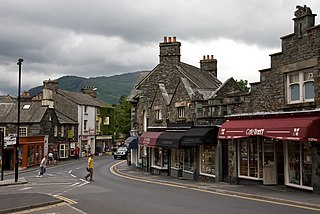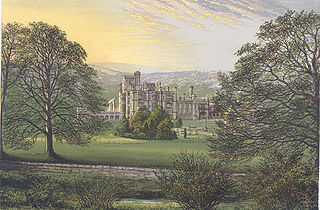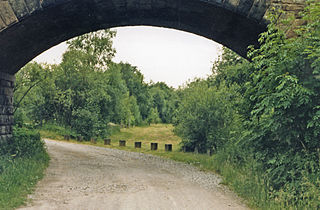
Leek is a market town and civil parish in the county of Staffordshire, England, on the River Churnet. It is situated about 10 miles (16 km) north east of Stoke-on-Trent. It is an ancient borough and was granted its royal charter in 1214.

Ambleside is a town and former civil parish in the Westmorland and Furness district of Cumbria, England. Within the boundaries of the historic county of Westmorland and located in the Lake District National Park, the town sits at the head of Windermere, England's largest natural lake. In 2020 it had an estimated population of 2596.

The North Staffordshire Railway (NSR) was a British railway company formed in 1845 to promote a number of lines in the Staffordshire Potteries and surrounding areas in Staffordshire, Cheshire, Derbyshire and Shropshire.

Rudyard Lake is a reservoir in Rudyard, Staffordshire, located north-west of the town of Leek, Staffordshire. It was constructed in the late 18th century to feed the Caldon Canal. During the 19th century, it was a popular destination for daytrippers taking advantage of easy access using the newly constructed North Staffordshire Railway. The lake is still used for many water activities such as boating, canoeing, fishing and also for walks and recreational steam train trips.

Uttoxeter railway station serves the town of Uttoxeter, Staffordshire, England. It is on the Crewe–Derby line, which is also a Community rail line known as the North Staffordshire line. The station is owned by Network Rail and managed by East Midlands Railway.

The Rudyard Lake Steam Railway is a ridable miniature railway and the third railway of any gauge to run along the side of Rudyard Lake in Staffordshire, England.

Ilam Park is a 158-acre (0.64 km2) country park situated in Ilam, on both banks of the River Manifold five miles (8 km) north west of Ashbourne, England, and in the ownership of the National Trust. The property is managed as part of the Trust's White Peak Estate.

Wilderhope Manor is a 16th-century manor house in the care of the National Trust. It is located on Wenlock Edge 7 miles (11 km) south west of Much Wenlock in Shropshire, England. The manor is a Grade I listed building and since 1937 has been used as a youth hostel.

Cliffe is a small village and civil parish in North Yorkshire, England. It was historically part of the East Riding of Yorkshire until 1974, but from 1974 to 2023 was in the Selby District of the shire county of North Yorkshire. In 2023 the district was abolished and North Yorkshire became a unitary authority.
The Churnet Valley line was one of the three original routes planned and built by the North Staffordshire Railway. Authorised in 1846, the line opened in 1849 and ran from North Rode in Cheshire to Uttoxeter in East Staffordshire. The line was closed in several stages between 1964 and 1988 but part of the central section passed into the hands of a preservation society and today operates as the Churnet Valley Railway.

The Youth Hostels Association is a charitable organisation, registered with the Charity Commission, providing youth hostel accommodation in England and Wales. It is a member of the Hostelling International federation.

Cliffe Park railway station was opened by the North Staffordshire Railway (NSR) in 1905 on the Churnet Valley line to attract visitors to Rudyard Lake, which the NSR were trying to develop as a leisure and tourist attraction including a golf course. The station was originally named Rudyard Lake and was at the northern end of the lake. There were no settlements nearby and consequently the station had no goods facilities. There was one siding but this was used more for stabling excursion trains rather than freight vehicles.

Rudyard railway station served Rudyard, Staffordshire and was opened by the North Staffordshire Railway (NSR) in 1850 on the Churnet Valley line. In the village the NSR also owned the Rudyard Hotel as part of the company's efforts to develop Rudyard Lake and its environs as a tourist destination.

St Edward's Hospital was a mental health facility at Cheddleton in Staffordshire, England. The hospital closed in 2002 and was converted into apartments and houses.

Trentham railway station was built by the North Staffordshire Railway (NSR) as part of the main line south from Stoke towards Stafford and served the village of Trentham, Staffordshire, England.

Trentham Gardens railway station was the last station built by the North Staffordshire Railway (NSR) and was the terminus of the short 1 mile 14 chains Trentham Park branch.

Bollington railway station was a railway station serving the town of Bollington in Cheshire, England. It was opened in 1869 by the Macclesfield, Bollington and Marple Railway (MB&M) - a joint line constructed and operated by the Manchester, Sheffield and Lincolnshire Railway (MS&L) and North Staffordshire Railways (NSR). The passenger station was on the north side of Grimshaw Lane, with a goods yard on the south side.

Higher Poynton was a railway station serving the eastern side of the town of Poynton in Cheshire, England. It was opened in 1869 by the Macclesfield, Bollington and Marple Railway (MB&M) - a joint line constructed and operated by the Manchester, Sheffield and Lincolnshire Railway (MS&L) and North Staffordshire Railways (NSR).

Winton Square in Stoke-on-Trent, Staffordshire, England, houses Stoke-on-Trent railway station, the North Stafford Hotel, and several other historic structures. The square was built in 1848 for the North Staffordshire Railway, whose headquarters were in the station building, and is a significant example of neo-Jacobean architecture. Today, all the buildings and structures in the square are listed buildings and the square is a designated conservation area.
Horton is a civil parish in the district of Staffordshire Moorlands, Staffordshire, England. It contains 29 listed buildings that are recorded in the National Heritage List for England. Of these, four are at Grade II*, the middle of the three grades, and the others are at Grade II, the lowest grade. The parish contains the villages of Horton and Rudyard, and the surrounding countryside. Most of the listed buildings are houses, including a former manor house and a country house, and associated structures, cottages, farmhouses and farm buildings. The other listed buildings include a church, an enclosure in the churchyard, a clapper bridge, and a former watermill.




















